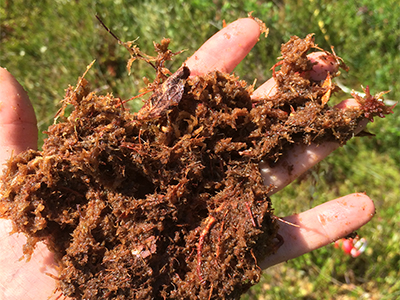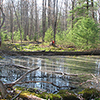Conservation Science
Protecting Pennsylvania's Plants and Animals
Peatlands
Peatlands represent a unique group of wetlands in Pennsylvania. This broad class of wetlands is defined by the accumulation of organic matter, called peat, under water-logged conditions. Organic material is often made up of partially decayed sphagnum moss and other plant materials. The rate at which organic material accumulates, and the suite of environmental conditions that drive peat formation, are what make peatlands unique. The Western Pennsylvania Conservancy continues to map and monitor peatlands throughout Pennsylvania. We provide management guidance to enhance conservation for these special places and the species that depend on them.
Most ecoregions of Pennsylvania tend to support unique peatland systems, but peatlands are not ubiquitous in the state. Northeastern Pennsylvania, especially areas that were glaciated, has more mapped peatlands than any other part of the state. Peatlands can also be found in northwestern Pennsylvania, which was also glaciated. These sites are often fens and more diverse than peatlands found elsewhere. Peatlands are less common in northcentral Pennsylvania, where the topography is made up of unglaciated plateaus and deep valleys. In Pennsylvania’s Ridge and Valley and Central Appalachians, peatlands are occasionally found on ridgetops.
Peatlands serve as the origin of some headwater aquatic systems. They play an important role in water recharge, water storage and regulation of stream flow for these systems. Given the important role of peatlands in providing these ecosystem services and the difficulty in restoring them, there is a need to provide better tools for protecting this special type of wetland.
Peatlands: A Race between Plant
Production and Plant Decomposition
Peat is an accumulation of undecomposed plant material. It can develop in a variety of wetland communities under a very specific set of environmental conditions.
Acidic Wetlands
 Peat often accumulates in nutrient-poor, acidic wetlands, which are often classified as sphagnum bogs, shrub wetlands or forested wetlands. In these systems, a lack of oxygen in the soil results in a slow process of decomposition. The rate of plant production often exceeds the rate of decay, resulting in an accumulation of peat. These systems tend to be nutrient-poor, which often influences the species of plants that can grow in these systems.
Peat often accumulates in nutrient-poor, acidic wetlands, which are often classified as sphagnum bogs, shrub wetlands or forested wetlands. In these systems, a lack of oxygen in the soil results in a slow process of decomposition. The rate of plant production often exceeds the rate of decay, resulting in an accumulation of peat. These systems tend to be nutrient-poor, which often influences the species of plants that can grow in these systems.
Nutrient-rich Fens
 There are certain wetland conditions that allow for abundant production and abundant decomposition. Unlike acidic peatlands, decomposition in productive wetlands may be much more rapid, either from flowing water (more oxygen) or greater microbial activity. However, these environmental conditions also support fast plant growth. Because production outpaces decomposition, peat can still accumulate over time. Nutrient-rich fens are a good example of this type of peatland. In nutrient-rich fens, plant communities are often more species-diverse as a result of gravel or limestone geology.
There are certain wetland conditions that allow for abundant production and abundant decomposition. Unlike acidic peatlands, decomposition in productive wetlands may be much more rapid, either from flowing water (more oxygen) or greater microbial activity. However, these environmental conditions also support fast plant growth. Because production outpaces decomposition, peat can still accumulate over time. Nutrient-rich fens are a good example of this type of peatland. In nutrient-rich fens, plant communities are often more species-diverse as a result of gravel or limestone geology.
Peatland Study and Classification
 By studying peatland soils, we can understand more about the history of a wetland, and the ecological processes that are occurring that allow peat to accumulate. The methods by which peatlands can be classified are immense. Environmental conditions, such as natural history (glaciated vs. non-glaciated; human disturbance ), water source, nutrient availability and pH all contribute to the classification of peatlands. Peatlands can also be sorted based on plant communities, indicator species or plant species diversity. In Pennsylvania, we use a data-driven, ecological approach to classification that considers environmental and biological data.
By studying peatland soils, we can understand more about the history of a wetland, and the ecological processes that are occurring that allow peat to accumulate. The methods by which peatlands can be classified are immense. Environmental conditions, such as natural history (glaciated vs. non-glaciated; human disturbance ), water source, nutrient availability and pH all contribute to the classification of peatlands. Peatlands can also be sorted based on plant communities, indicator species or plant species diversity. In Pennsylvania, we use a data-driven, ecological approach to classification that considers environmental and biological data.
Glaciation, Human Disturbance
and Peatland Formation
Natural history has played a role in the formation of peatlands. Over time, human history has also impacted in the lifespan and trajectory of peatland wetlands.
Glacial Impacts on Peatlands

Glaciation impacted soils and topography in northwest and northeast Pennsylvania, making them suitable for accumulation of water, and over time, the accumulation of peat. Kettle-hole bogs, sometimes called lake-fill peatlands, are a great example of peatlands that have developed as a result of glaciation.
Over thousands of years, plants at the periphery of glacial lakes or kettle-holes have filled in with vegetation. Over time, peat and sediment accumulation provide rooting substrate for other plants to establish. For example, kettle-holes can transform from an open water system to an entirely vegetated wetland. Often, kettle-hole bogs reveal much information about how plant communities change over time in peatland systems.
Human Impacts on Peatland
 More recent disturbances have “reset” peatlands to an earlier successional state. For example, there are a number of peatland wetlands in southwestern Pennsylvania that are relatively young, forming as a result of timber removal. Spruce Flats Bog, located within Forbes State Forest in Westmoreland and Somerset counties, was logged in the early 1900s. While this hemlock forest was reported to be a wetland prior to logging, subsequent wildfires and water accumulation facilitated by the site’s geology have allowed peat to accumulate. Spruce Flats Bog supports many bog species that, while common in the northeastern part of the state, are regionally uncommon in southwest Pennsylvania.
More recent disturbances have “reset” peatlands to an earlier successional state. For example, there are a number of peatland wetlands in southwestern Pennsylvania that are relatively young, forming as a result of timber removal. Spruce Flats Bog, located within Forbes State Forest in Westmoreland and Somerset counties, was logged in the early 1900s. While this hemlock forest was reported to be a wetland prior to logging, subsequent wildfires and water accumulation facilitated by the site’s geology have allowed peat to accumulate. Spruce Flats Bog supports many bog species that, while common in the northeastern part of the state, are regionally uncommon in southwest Pennsylvania.
South Fork Connemaugh Wetland, found in Gallitzin State Forest in Somerset County, is another example of a peatland that can develop in response to human disturbance. Soil removal and restructuring that resulted from surface mining has led to peat formation at this site. Currently, South Fork Connemaugh Wetland supports a Cotton-grass Poor Fen , shrub wetland, and red maple-dominated forested wetlands along its margins.







